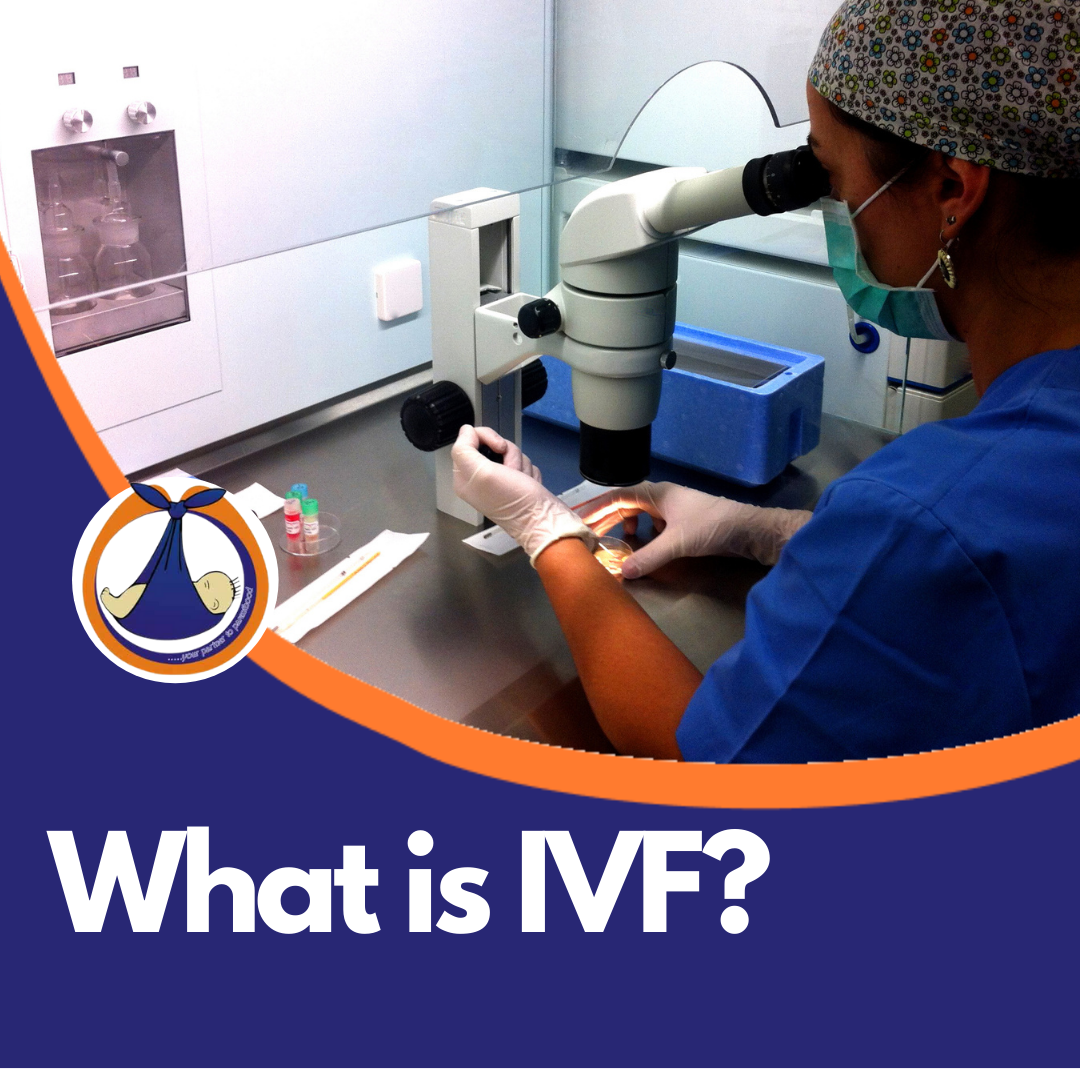
What is IVF?
IVF stands for in vitro fertilization. IVF works by using a combination of medical, surgical and laboratory procedures to help sperm fertilize an egg, and help the developing fertilized egg(s) implant in your uterus.
How does it work?
First, you take medication that makes several of your eggs mature and ready for fertilization. Then the doctor takes the eggs out of your body and mixes them with your partner’s sperm in an IVF lab, to help the sperm fertilize the eggs. Then they put 1 or more fertilized eggs (embryos) directly into your uterus. Pregnancy happens if any of the embryos implants in the lining of your uterus.
IVF has many steps, and it takes a couple of weeks to complete the whole process. It sometimes works on the first try, but many people need more than 1 attempt at IVF to get pregnant.
What’s the IVF process?
Normally, an egg and sperm are fertilized inside a woman’s body. If the fertilized egg attaches to the lining of the womb and continues to grow, a baby is born about 9 months later. This process is called natural or unassisted conception.
IVF is a form of assisted reproductive technology (ART). This means special medical techniques are used to help a woman become pregnant. It is most often tried when other, less expensive fertility techniques have failed.
There are five basic steps to IVF:
Step 1: Stimulation, also called superovulation
- Medicines, called fertility drugs, are given to the woman to boost egg production upon all investigations.
- Normally, a woman produces one egg per month. Fertility drugs allow the ovaries to produce several eggs.
- During this step, the woman will have regular transvaginal ultrasounds to examine the ovaries and blood tests to check hormone levels.
Step 2: Egg retrieval
- A mini surgery, called follicular aspiration, is done to remove the eggs from the woman’s ovaries.
- The surgery is done in the doctor’s office most of the time. The woman will be given medicines so she does not feel pain during the procedure. Using ultrasound images as a guide, the health care provider inserts a thin needle through the vagina into the ovary and sacs (follicles) containing the eggs. The needle is connected to a suction device, which pulls the eggs and fluid out of each follicle, one at a time.
- The procedure is repeated for the other ovary. There may be some cramping after the procedure, but it will go away within a day.
- In rare cases, a pelvic laparoscopy may be needed to remove the eggs. If a woman does not or cannot produce any eggs, donated eggs may be used.
Step 3: Insemination and Fertilization
- The man’s sperm is placed together with the best quality eggs. The mixing of the sperm and egg is called in vitro insemination.
- Eggs and sperm are then stored in a chamber that has an internal milieu mimicking the human womb. The sperm most often enters (fertilizes) an egg a few hours after insemination.
- If the doctor thinks the chance of fertilization is low, the sperm may be directly injected into the egg. This is called intracytoplasmic sperm injection (ICSI).
- Many fertility programs routinely do ICSI on some of the eggs, even if things appear normal.
Step 4: Embryo culture
- When the fertilized egg divides, it becomes an embryo. Laboratory staff will regularly check the embryo to make sure it is growing properly. Within about 5 days, a normal embryo has several cells that are actively dividing.
- Couples who have a high risk of passing a genetic (hereditary) disorder to a child may consider pre-implantation genetic diagnosis (PGD). The procedure is most often done 3 to 5 days after fertilization. Laboratory scientists remove a single cell or cells from each embryo and screen the material for specific genetic disorders.
- According to the American Society for Reproductive Medicine, PGD can help parents decide which embryos to implant. This decreases the chance of passing a disorder onto a child. The technique allows for the determination of unborn baby sex and
Step 5: Embryo transfer
- Embryos are placed into the woman’s womb 3 to 5 days after egg retrieval and fertilization.
- The procedure is done in the IVF theatre while the woman is awake. The doctor inserts a thin tube (catheter) containing the embryos into the woman’s vagina, through the cervix, and up into the womb. If an embryo sticks to (implants) in the lining of the womb and grows, pregnancy results.
- More than one embryo may be placed into the womb at the same time, which can lead to twins, triplets, or more. The exact number of embryos transferred is a complex issue that depends on many factors, especially the woman’s age.
- Unused embryos may be frozen and implanted or donated at a later date.
Why you may qualify for IVF
Sometimes, IVF is offered as a primary treatment for infertility in women over age 40. IVF can also be done if you have certain health conditions. For example, IVF may be an option if you or your partner has:
- Fallopian tube damage or blockage. Fallopian tube damage or blockage makes it difficult for an egg to be fertilized as sperm do not get access to the ovulated egg or for an embryo to travel to the uterus.
- Ovulation disorders.If ovulation is infrequent or absent, fewer eggs are available for fertilization.
- Endometriosis occurs when the uterine tissue implants and grows outside of the uterus — often affecting the function of the ovaries, uterus, and fallopian tubes.
- Uterine fibroids. Fibroids are benign tumors in the wall of the uterus and are common in women in their 30s and 40s. Fibroids can interfere with the implantation of the fertilized egg.
- Previous tubal sterilization or removal.If you’ve had tubal ligation — a type of sterilization in which your fallopian tubes are cut or blocked to permanently prevent pregnancy — and want to conceive, IVF may be an alternative to tubal ligation reversal.
- Impaired sperm production or function. Below-average sperm concentration, weak movement of sperm (poor mobility), or abnormalities in sperm size and shape can make it difficult for sperm to fertilize an egg. If semen abnormalities are found, your partner might need to see a specialist to determine if there are correctable problems or underlying health concerns.
- Unexplained infertility. Unexplained infertility means no cause of infertility has been found despite evaluation for common causes.
- A genetic disorder.If you or your partner is at risk of passing on a genetic disorder to your child, you may be candidates for preimplantation genetic testing — a procedure that involves IVF. After the eggs are harvested and fertilized, they’re screened for certain genetic problems, although not all genetic problems can be found. Embryos that don’t contain identified problems can be transferred to the uterus.
- Fertility preservation for cancer or other health conditions.If you’re about to start cancer treatment — such as radiation or chemotherapy — that could harm your fertility, IVF for fertility preservation may be an option. Women can have eggs harvested from their ovaries and frozen in an unfertilized state for later use. Or the eggs can be fertilized and frozen as embryos for future use.
Women who don’t have a functional uterus or for whom pregnancy poses a serious health risk might choose IVF using another person to carry the pregnancy (gestational carrier). In this case, the woman’s eggs are fertilized with sperm, but the resulting embryos are placed in the gestational carrier’s uterus.
After the procedure
After the embryo transfer, you can resume normal daily activities. However, your ovaries may still be enlarged. Consider avoiding vigorous activity, which could cause discomfort.
Typical side effects include:
- Passing a small amount of clear or bloody fluid shortly after the procedure — due to the swabbing of the cervix before the embryo transfer
- Breast tenderness due to high oestrogen levels
- Mild bloating
- Mild cramping
- Constipation
If you develop moderate or severe pain after the embryo transfer, contact your doctor. He or she will evaluate you for complications such as infection, twisting of an ovary (ovarian torsion) and severe ovarian hyperstimulation syndrome.
Results
About 12 days to two weeks after egg retrieval, your doctor will test a sample of your blood to detect whether you’re pregnant.
- If you’re pregnant, your doctor will refer you to an obstetrician or other pregnancy specialist for prenatal care.
- If you’re not pregnant, you’ll stop taking drugs and hormones (progesterone) and likely get your period within a week. If you don’t get your period or you have unusual bleeding, contact your doctor. If you’re interested in attempting another cycle of in vitro fertilization (IVF), your doctor might suggest steps you can take to improve your chances of getting pregnant through IVF.
The chances of giving birth to a healthy baby after IVF treatment depends on various factors, including:
- Maternal age. The younger you are, the more likely you are to get pregnant and give birth to a healthy baby using your own eggs during IVF. Women age 38yrs and older are often counseled to consider using donor eggs during IVF to increase the chances of success.
- Embryo status. Transfer of embryos that are more developed is associated with higher pregnancy rates compared with less developed embryos (day two or three). However, not all embryos survive the development process. Talk with your doctor or another care provider about your specific situation.
- Reproductive history. Women who’ve previously given birth are more likely to be able to get pregnant using IVF than are women who’ve never given birth. Success rates are lower for women who’ve previously used IVF multiple times but didn’t get pregnant.
- Cause of infertility. Having a normal supply of eggs increases your chances of being able to get pregnant using IVF. Women who have severe endometriosis are less likely to be able to get pregnant using IVF than are women who have unexplained infertility.
- Lifestyle factors. Women who smoke typically have fewer eggs retrieved during IVF and may miscarry more often. Smoking can lower a woman’s chance of success using IVF by 50%. Obesity can decrease your chances of getting pregnant and having a baby. The use of alcohol, recreational drugs, excessive caffeine, and certain medications also can be harmful.
As the best IVF clinic in Lagos Nigeria, Omega Golden Fertility offers the best IVF procedure in Lagos Nigeria with a highly specialized and premium assisted reproduction centre in Lagos Nigeria. As the best IVF specialist in Lagos Nigeria, we offer the best fertility treatment in Lagos Nigeria by bringing smile and completeness to families.
Talk to us about any factors that apply to you and how they may affect your chances of a successful pregnancy.
Kindly follow us on our social media pages for more regular updates:


